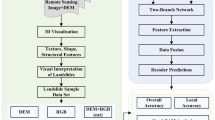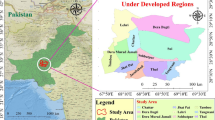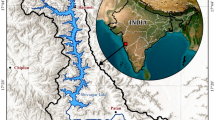Abstract
Landslide spatial decision support systems (LS-DSS) are computer-based systems that combine the geographic storage, search, and retrieval capabilities of geographic information systems with the decision models and optimizing algorithms used to support decision-making for landslide problems. This study proposes an optimization process of region object-oriented classification (ROC) to analyze the landslide image information. The surface information from the Wan Da reservoir area is collected and studied. We collected different spectrum with several texture information to analyze the surrounding area of the Wan Da reservoir. ROC is used to classify the landslide area. Entropy-based classification is used as a classifier in ROC to determine the landslide/nonlandslide area. The parameters of S (similarity) and A (area) are used and then the best combinations are found. An optimize algorithm is developed to access the above variables to perform the best classification outcomes. The relations of occurrence vs. non-occurrence of landslide which are linked to the attributes of land surface are studied. An improved translation model (Expert Knowledge Translation Platform) is also presented to increase the accuracy. This could be of help to manage/monitor the landslide area near the reservoir.









Similar content being viewed by others
References
Abdalla EME, Zeinelabdein KAE, Khidir SOHEI, Gachet A (2011) The application of remote sensing and structural analysis in groundwater exploration in basement terrains, Darfur region, Western Sudan. Arab J Geosci. doi:10.1007/s12517-011-0468-3
Akgun A, Sezer EA, Nefeslioglu HA, Gokceoglu C, Pradhan B (2012) An easy-to-use MATLAB program (MamLand) for the assessment of landslide susceptibility using a Mamdani fuzzy algorithm. Comput Gesosci 38(1):23–34
Aleotti P, Chowdhury R (1999) Landslide hazard assessment: summary review and new perspectives. Bull Eng Geol Env 58:21–44
Althuwaynee OF, Pradhan B, Lee S (2012) Application of an evidential belief function model in landslide susceptibility mapping. Comput Gesosci 44:120–135
Bannari A, Morin D, Bonn F, Huete AR (1995) A review of vegetation indices. Remote Sens Rev 13:95–120
Blaschke T, Strobl J (2001) What’s wrong with pixels? Some recent developments interfacing remote sensing and GIS. GeoBIT/GIS 6:12–17
Carr JR, Miranda FP (1998) The Semivariogram in Comparison to the Co-occurrence Matrix for Classification of Image Texture. IEEE Trans Geosci Remote Sens 36(6):1945–1952
Chica-Olmo M, Abarca-Hernández F (2000) Computing Geostatistical Image Texture for Remotely Sensed Data Classification. Comput Gesosci 26(4):373–383
Dai FC, Lee FC (2002) Landslide characteristics and slope instability modeling using GIS, Lantau island, Hong Kong. Geomorphology 42:213–228
Espindola GM, Camara G, Reis IA, Bins LS, Monteiro AM (2006) Parameter selection for region growing image segmentation algorithms using spatial autocorrelation. Int J Remote Sens 27:3035–3040
Habi M, Morsli B (2011) Impact of water and soil conservation (WSC) strategies in improving water balance and soil production in Algeria: options to alleviate the negative impacts of climate change. Arab J Geosci 1–8
Haralick RM, Shapiro LG (1985) Image segmentation techniques. Comput Vision Graph Image Process 29:100–132
Haralick RM, Shaunmmugam K, Dinstein I (1973) Textural Features for Image Classification. IEEE Trans Syst Man Cybern 67:786–804
Hassan AHA, Abu EBS (2012) Assessment of aquifer vulnerability to contamination in Khanyounis Governorate, Gaza Strip-Palestine, using the DRASTIC model within GIS environment. Arab J Geosci 5(4):833–847
Huang PC, Wan S, Yen JY (2008) A Novel Method of Searching Appropriate Ranges of Base Isolation Design Parameters Through Entropy-based Classification. Struct Contr Healh Monito 16(14):385–405
Lei TC, Wan S, Li J Y, Yeh HC (2009) Using Regional Object Classification Model to Extract Paddy Rice Patch from ADS- 40 Image, 30th Asia Conf. on Remote Sens (ACRS2009), Beijing, China
Lu D, Weng Q (2007) A survey of image classification methods and techniques for improving classification performance. Int J Remote Sens 28(5):823–870
Marceau DJ, Howarth PJ, Dubois JM, Gratton DJ (1990) Evaluation of the Grey-level Co-occurrence Matrix Method for Land-cover Classification using SPOT Image. IEEE Trans Geosci Remote Sens 28(4):513–519
Maruyama T, Kawachi T, Singh VP (2005) Entropy-based assessment and clustering of potential water resources availability. J Hydrol 309:104–113
Pal NR, Pal SK (1993) A review on image segmentation techniques. Pattern Recogn 26(9):1277–1294
Pourghasemi HR, Pradhan B, Gokceoglu C (2012) Application of fuzzy logic and analytical hierarchy process (AHP) to landslide susceptibility mapping at Hazard watershed, Iran. Nat Hazards 63(2):965–996
Pradhan B (2010) Manifestation of an advanced fuzzy logic model coupled with geoinformation techniques for landslide susceptibility analysis. Environ Ecol Stat. doi:10.1007/s10651-010-0147-7
Pradhan B, Buchroithner MF (2010) Comparison and validation of landslide susceptibility maps using an artificial neural network model for three test areas in Malaysia. Environ Eng Geosci 16(2):107–126
Pradhan B, Lee S (2010) Landslide susceptibility assessment and factor effect analysis: back propagation artificial neural networks and their comparison with frequency ratio and bivariate logistic regression modelling. Environ Model Soft 25(6):747–759
Pradhan B, Youssef AM (2010) Manifestation of remote sensing data and GIS on landslide hazard analysis using spatial-based statistical models. Arab J Geosci 3(3):319–326
Pradhan B, Oh HJ, Buchroithner M (2010) Weights-of-evidence model applied to landslide susceptibility mapping in a tropical hilly area. Geomatics, Natural Hazard and Risk 1(3):199–223
Pradhan B, Mansor S, Pirasteh S, Buchroithner MF (2011) Landslide hazard and risk analyses at a landslide prone catchment area using statistical based geospatial model. Int J Remote Sens 32(14):4075–4087
Salvi G (2006) Segment boundary detection via class entropy measurements in connectionist phoneme recognition. Speech Commun 48:1666–1676
Soille P (1999) Morphological image analysis: Principles and applications, Springer-Verlag Telos, ISBN-3540656715
Vorko A, Jovic F (2000) Multiple attribute entropy classification of school-age injuries. Accid Anal Prevent 32:445–454
Wan S (2009) A spatial decision support system for extracting the core factors and thresholds for landslide susceptibility map. Eng Geol 108:237–251
Wan S, Lei TC (2009) A Knowledge-based Decision Support System to Analyze the Debris-Flow Problems at Chen Yu-Lan River, Taiwan. Knowl Based Syst 22:580–588
Wan S, Lei TC, Chou TY (2009) A novel data mining technique of analysis and classification for landslide problems. Nat Hazards 52:211–230
Wan S, Lei TC, Chou TY (2010) A novel data mining technique of analysis and classification for landslide problems. Nat Hazards. doi:10.1007/s11069-009-9366-3
Wan S, Lei TC, Chou TY (2012) A landslide expert system: image classification through integration of data mining approaches for multi- category analysis. Int J Geogr Inf Sci 26:747–770
Wang L, Sousa WP, Gong P (2004) Integration of object-based and pixel-based classification for mapping mangroves with IKONOS imagery. Int J Geogr Inf Sci 25(24):5655–5668
Yilmaz I (2010) Comparison of landslide susceptibility mapping methodologies for Koyulhisar, Turkey: conditional probability, logistic regression, artificial neural networks, and support vector machine. Environ Earth Sci 61:821–836
Author information
Authors and Affiliations
Corresponding author
Rights and permissions
About this article
Cite this article
Wan, S., Lei, T.C. & Chou, T.Y. Optimized object-based image classification: development of landslide knowledge decision support system. Arab J Geosci 7, 2059–2070 (2014). https://doi.org/10.1007/s12517-013-0952-z
Received:
Accepted:
Published:
Issue Date:
DOI: https://doi.org/10.1007/s12517-013-0952-z




